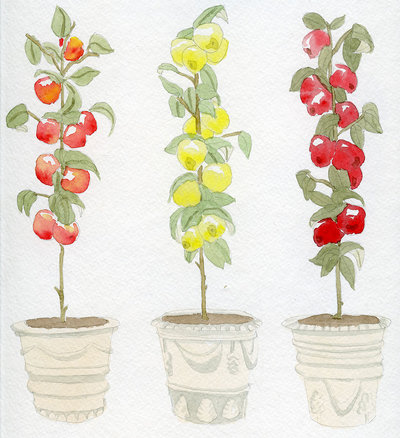
These days, you can grow apples without the hard work, responsibilities or space required by full-size apple trees.
Cute and amazingly compact, columnar apple trees can grow up to 10 feet tall or higher while remaining barely 2 feet wide, and they can be spaced as close as 2 feet apart. The trees need minimal to no pruning, because the few side branches they produce grow vertically and can be removed, shortened or left to increase the crop.
Columnar trees produce normal-size apples within a year or two after planting. A single mature columnar apple tree can produce several pounds of fruit, with good fruiting years alternating with light ones, as is normal with most apple trees. Two varieties for good pollination are necessary, unless there are other apple trees nearby. Columnar trees may need to be staked or secured to a fence in windy locations.
I used to view columnar apples as a frivolous novelty, but I’ve come to appreciate their advantages. Friends who already grow them seem satisfied to seriously delighted with their teeny trees.
Catalog descriptions hold true: The trees fruit early and well, and they grow within the dimensions claimed. Happy to grow in pots, they can sit on a sunny balcony or patio, and then be packed up when you move houses. Containers do need to be large, at least 20 inches deep and wide. The only complaints are the expensive cost ($30-$80) and the lack of varieties.
Columnar apples have unfamiliar names due to the fact they are genetically different from the apples we know and love. Columnar trees arose as “sports” or mutations, with a columnar gene.
The mutation was first identified in a new shoot on an old limb of a MacIntosh apple tree in a British Columbia orchard. That shoot or a similar sport on a MacIntosh gave rise to the columnar variety now sold as “Northpole,” which tastes similar to MacIntosh.
The same mutation has since occurred on other trees, and seven or eight varieties are now available, with different fruit colors and flavors. All are patented; some are marketed (and trademarked) such as Colonnade or Urban Apples.
In addition to the varieties available as columnar apples, there are also mini-dwarf trees. Mini-dwarfs are regular apple varieties grafted on an ultra-dwarfing rootstock (such as M27). An ordinary “dwarf” apple tree (an M26) is likely to grow 8 to 12 feet high and 5 to 10 wide, depending on the inherent vigor of the variety. A mini-dwarf, according to Raintree Nursery, can be “easily maintained at only 5 to 7 feet tall and 4 to 6 feet wide.”
Raintree offers 20 varieties of minis, including some familiar varieties such as Liberty, Melrose, Jonagold and Honeycrisp. They are available as 1- to 3-foot bare-root trees and should bear fruit in about three years. Because of their small root system, they definitely need support.
A good way to grow such trees is as informal espaliers (plants grown along a flat plane) on wires stretched between posts. They will need good soil and more regular irrigation and feeding than larger trees with bigger root systems that can forage further for water and nutrients.
A major advantage of really small apples trees — columnar or mini-dwarf — is that they give you better control over fruit quality. Perfect apples are tough to grow if you are an organic gardener. Disease-resistant varieties really help, but you still have to worry about codling moth, the critter whose larvae make frass-filled tunnels through your fruit.
The best protection against bugs is to thin and bag your fruit. Yes, that means putting a paper or mesh bag over each and every apple you want to keep! Both operations are much easier to do on a little tree than on a large one. Growing a row of tiny trees will be easier to protect and easier to pick. Of course, you’ll still want to practice good hygiene, which means cleaning up all leaves and any fallen apples.
Columnar and/or mini-dwarf apples are available from suppliers including One Green World, Raintree Nursery and Stark Bro’s. Locally, Down to Earth will have a good selection of potted columnar apples in two sizes.